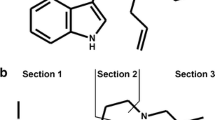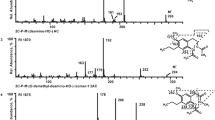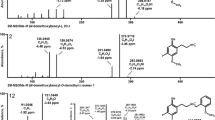Abstract
Derivatives of N,N-diallyltryptamine (DALT) can be classified as new psychoactive substances. Biotransformation and detectability of 5-fluoro-DALT (5-F-DALT), 7-methyl-DALT (7-Me-DALT), and 5,6-methylenedioxy-DALT (5,6-MD-DALT) are described here. Their metabolites detected in rat urine and pooled human liver microsomes were identified by liquid chromatography (LC)–high resolution (HR)–tandem mass spectrometry (MS/MS). In addition, the human cytochrome-P450 (CYP) isoenzymes involved in the main metabolic steps were identified and detectability tested in urine by the authors’ urine screening approaches using GC-MS, LC-MSn, or LC-HR-MS/MS. Aromatic and aliphatic hydroxylations, N-dealkylation, N-oxidation, and combinations could be proposed for all compounds as main pathways. Carboxylation after initial hydroxylation of the methyl group could also be detected for 7-Me-DALT and O-demethylenation was observed for 5,6-MD-DALT. All phase I metabolites were extensively glucuronidated or sulfated. Initial phase I reactions were catalyzed by CYP1A2, CYP2B6, CYP2C9, CYP2C19, CYP2D6, CYP3A4, and CYP3A5. Rat urine samples were analyzed following two different low-dose administrations. GC-MS was not able to monitor consumption reliably, but all three compounds are predicted to be detectable in cases of overdose. The LC-MSn and LC-HR-MS/MS approaches were suitable for detecting an intake of all three compounds mainly via their metabolites. However, after the lowest dose, a reliable monitoring could only be achieved for 5-F-DALT via LC-MSn and LC-HR-MS/MS and for 7-Me-DALT via LC-HR-MS/MS. The most abundant targets in both LC-MS screenings were one of two hydroxy-aryl metabolites and both corresponding glucuronides for 5-F-DALT, one N-deallyl hydroxy-aryl, the carboxy, and one dihydroxy-aryl metabolite for 7-Me-DALT, and the demethylenyl metabolite, its oxo metabolite, and glucuronide for 5,6-MD-DALT.





Similar content being viewed by others
References
Brandt SD, King LA, Evans-Brown M. The new drug phenomenon. Drug Test Anal. 2014;6:587–97.
United Nations Office on Drugs and Crime (UNODC) (2014) World Drug Report 2014. http://www.unodc.org/documents/data-and-analysis/WDR2014/World_Drug_Report_2014_web.pdf
United Nations Office on Drugs and Crime (UNODC) (2015) World Drug Report 2015. https://www.unodc.org/documents/wdr2015/World_Drug_Report_2015.pdf
United Nations Office on Drugs and Crime (UNODC) (2016) World Drug Report 2016. https://www.unodc.org/doc/wdr2016/WORLD_DRUG_REPORT_2016_web.pdf
Palamar JJ, Martins SS, Su MK, Ompad DC. Self-reported use of novel psychoactive substances in a US nationally representative survey: prevalence, correlates, and a call for new survey methods to prevent underreporting. Drug Alcohol Depend. 2015;156:112–9.
Sanders B, Lankenau SE, Bloom JJ, Hathazi D. “Research chemicals”: tryptamine and phenethylamine use among high-risk youth. Subst Use Misuse. 2008;43:389–402.
Corkery JM, Durkin E, Elliott S, Schifano F, Ghodse AH. The recreational tryptamine 5-MeO-DALT (N, N-diallyl-5-methoxytryptamine): a brief review. Prog Neuropsychopharmacol Biol Psychiatry. 2012;39:259–62.
Jovel A, Felthous A, Bhattacharyya A. Delirium due to intoxication from the novel synthetic tryptamine 5-MeO-DALT. J Forensic Sci. 2014;59:844–6.
Michely JA, Helfer AG, Brandt SD, Meyer MR, Maurer HH. Metabolism of the new psychoactive substances N, N-diallyltryptamine (DALT) and 5-methoxy-DALT and their detectability in urine by GC-MS, LC-MSn, and LC-HR-MS/MS. Anal Bioanal Chem. 2015;407:7831–42.
Meyer MR, Maurer HH. Review: LC coupled to low- and high-resolution mass spectrometry for new psychoactive substance screening in biological matrices—where do we stand today? Anal Chim Acta. 2016;927:12–20.
Peters FT. Recent developments in urinalysis of metabolites of new psychoactive substances using LC-MS. Bioanalysis. 2014;6:2083–107.
Brandt SD, Tirunarayanapuram SS, Freeman S, Dempster N, Barker SA, Daley PF, et al. Microwave-accelerated synthesis of psychoactive deuterated N, N-dialkylated-[alpha, alpha, beta, beta-d(4)]-tryptamines. J Label Compd Radiopharm. 2008;51:423–9.
Cozzi NV, Daley PF. Receptor binding profiles and quantitative structure-affinity relationships of some 5-substituted-N, N-diallyltryptamines. Bioorg Med Chem Lett. 2016;26:959–64.
Brandt SD, Kavanagh PV, Dowling G, Talbot B, Westphal F, Meyer MR, et al. Analytical characterization of N, N-diallyltryptamine (DALT) and 16 ring-substituted derivatives. Drug Test Anal. 2016. doi:10.1002/dta.1974.
Meyer MR, Caspar A, Brandt SD, Maurer HH. A qualitative/quantitative approach for the detection of 37 tryptamine-derived designer drugs, 5 beta-carbolines, ibogaine, and yohimbine in human urine and plasma using standard urine screening and multi-analyte approaches. Anal Bioanal Chem. 2014;406:225–37.
Maurer HH, Pfleger K, Weber AA. Mass spectral data of drugs, poisons, pesticides, pollutants and their metabolites. Weinheim (Germany): Wiley-VCH; 2016.
Wissenbach DK, Meyer MR, Remane D, Philipp AA, Weber AA, Maurer HH. Drugs of abuse screening in urine as part of a metabolite-based LC-MS(n) screening concept. Anal Bioanal Chem. 2011;400:3481–9.
Helfer AG, Michely JA, Weber AA, Meyer MR, Maurer HH. Orbitrap technology for comprehensive metabolite-based liquid chromatographic-high resolution-tandem mass spectrometric urine drug screening—exemplified for cardiovascular drugs. Anal Chim Acta. 2015;891:221–33.
Wissenbach DK, Meyer MR, Remane D, Weber AA, Maurer HH. Development of the first metabolite-based LC-MSn urine drug screening procedure—exemplified for antidepressants. Anal Bioanal Chem. 2011;400:79–88.
Meyer MR, Vollmar C, Schwaninger AE, Maurer HH. New cathinone-derived designer drugs 3-bromomethcathinone and 3-fluoromethcathinone: studies on their metabolism in rat urine and human liver microsomes using GC-MS and LC-high-resolution MS and their detectability in urine. J Mass Spectrom. 2012;47:253–62.
Maurer HH, Pfleger K, Weber AA. Mass spectral library of drugs, poisons, pesticides, pollutants and their metabolites. Weinheim (Germany): Wiley-VCH; 2016.
Meyer MR, Peters FT, Maurer HH. Automated mass spectral deconvolution and identification system for GC-MS screening for drugs, poisons, and metabolites in urine. Clin Chem. 2010;56:575–84.
Maurer HH, Wissenbach DK, Weber AA. Maurer/Wissenbach/Weber MWW LC-MSn library of drugs, poisons, and their metabolites. Weinheim (Germany): Wiley-VCH; 2014.
Niessen WMA. Fragmentation of toxicologically relevant drugs in positive-ion liquid chromatography-tandem mass spectrometry. Mass Spectrom Rev. 2011;30:626–63.
Brandt SD, Martins CPB. Analytical methods for psychoactive N, N-dialkylated tryptamines. Trends Anal Chem. 2010;29:858–69.
Helfer AG, Turcant A, Boels D, Ferec S, Lelievre B, Welter J, et al. Elucidation of the metabolites of the novel psychoactive substance 4-methyl-N-ethyl-cathinone (4-MEC) in human urine and pooled liver microsomes by GC-MS and LC-HR-MS/MS techniques and of its detectability by GC-MS or LC-MSn standard screening approaches. Drug Test Anal. 2015;7:368–75.
Meyer MR, Maurer HH. Metabolism of designer drugs of abuse: an updated review [review]. Curr Drug Metab. 2010;11:468–82.
Caspar AT, Helfer AG, Michely JA, Auwaerter V, Brandt SD, Meyer MR, et al. Studies on the metabolism and toxicological detection of the new psychoactive designer drug 2-(4-iodo-2,5-dimethoxyphenyl)-N-[(2-methoxyphenyl)methyl]ethanamine (25I-NBOMe) in human and rat urine using GC-MS, LC-MSn, and LC-HR-MS/MS. Anal Bioanal Chem. 2015;407:6697–719.
Wink CSD, Meyer MR, Braun T, Turcant A, Maurer HH. Biotransformation and detectability of the designer drug 2,5-dimethoxy-4-propylphenethylamine (2C-P) studied in urine by GC-MS, LC-MSn and LC-high resolution-MSn. Anal Bioanal Chem. 2015;407:831–43.
Wohlfarth A, Roman M, Andersson M, Kugelberg FC, Diao X, Carlier J, et al. 25C-NBOMe and 25I-NBOMe metabolite studies in human hepatocytes, in vivo mouse and human urine with high-resolution mass spectrometry. Drug Test Anal. 2016. doi:10.1002/dta.2044.
Dinger J, Meyer MR, Maurer HH. In vitro cytochrome P450 inhibition potential of methylenedioxy-derived designer drugs studied with a two cocktail approach. Arch Toxicol. 2016;90:305–18.
Wink CSD, Meyer GMJ, Meyer MR, Maurer HH. Toxicokinetics of lefetamine and derived diphenylethylamine designer drugs—contribution of human cytochrome P450 isozymes to their main phase I metabolic steps. Toxicol Lett. 2015;238:39–44.
Shulgin AT. Basic pharmacology and effects. In: Laing RR, editor. Halluinogens. A forensic drug handbook. London: Elsevier Science; 2003. p. 67–137.
Shulgin AT, Shulgin A (2004) 5-MeO-DALT. http://isomerdesign.com/PiHKAL/read.php?domain=tk&id=56
Shulgin AT, Shulgin A (2004) DALT. http://isomerdesign.com/PiHKAL/read.php?domain=tk&id=57
Sharma V, McNeill JH. To scale or not to scale: the principles of dose extrapolation. Br J Pharmacol. 2009;157:907–21.
Kovats E. Gaschromatographische Charakterisierung organischer Verbindungen. Teil 1. Retentionsindices aliphatischer Halogenide, Alkohole, Aldehyde und Ketone. Helv Chim Acta. 1958;41:1915–32.
Acknowledgements
The authors like to thank Achim T. Caspar, Julia Dinger, Andreas G. Helfer, Jessica Welter, Carina S. D. Wink, Carsten Schröder, Gabriele Ulrich, and Armin A. Weber for their support and/or helpful discussion.
Author information
Authors and Affiliations
Corresponding author
Ethics declarations
The authors declare that the experiments have been conducted in accordance with animal ethical care.
Conflict of interest
The authors declare that they have no competing interests.
Electronic supplementary material
Below is the link to the electronic supplementary material.
ESM 1
(PDF 2.75 mb)
Rights and permissions
About this article
Cite this article
Michely, J.A., Brandt, S.D., Meyer, M.R. et al. Biotransformation and detectability of the new psychoactive substances N,N-diallyltryptamine (DALT) derivatives 5-fluoro-DALT, 7-methyl-DALT, and 5,6-methylenedioxy-DALT in urine using GC-MS, LC-MSn, and LC-HR-MS/MS. Anal Bioanal Chem 409, 1681–1695 (2017). https://doi.org/10.1007/s00216-016-0117-5
Received:
Revised:
Accepted:
Published:
Issue Date:
DOI: https://doi.org/10.1007/s00216-016-0117-5




